Constant-Frequency Model Predictive Direct Power Control for Fault-Tolerant Bidirectional Voltage-Source Converter with Balanced Capacitor Voltage
Abstract
1. Introduction
2. Model of Fault-Tolerant BVSC
2.1. Fault-Tolerant Operation Analysis
2.2. Predictive Power Model
2.3. DC-Link Midpoint Voltage-Offset Suppression
3. Control Method for a Fault-Tolerant BVSC
3.1. Theoretical Analysis of the Constant-Frequency MPC (CF-MPC) Method
3.2. CF-MPC Method for Fault-Tolerant BVSC
4. Simulation and Experiment Results
4.1. Simulation Results for Fault-Tolerant BVSC
4.2. Experiment Results for Fault-Tolerant BVSC
5. Conclusions
- Through fault-tolerant operation analysis of a TPFS structure, the output voltages in an αβ stationary frame and the corresponding voltage vectors with a phase fault were established. Then, the predictive power model and DC-link voltage offset were obtained to prepare for the control strategy.
- The CF-MPDPC method was proposed to realize direct power control based on three output vectors with constant frequency, which can more accurately track the optimal vector and reduce current harmonics. Furthermore, the balance control of DC-link capacitor voltages was also achieved to protect the converter against second faults with an electrolytic capacitor for overvoltage operations by adding the term of a DC-link center-point voltage offset into the cost function.
- From the simulation and experimental results, it can be seen that the proposed CF-MPDPC for a fault-tolerant TPFS converter outperforms the traditional MPDPC for BVSC and MPDPC for a fault-tolerant TPFS converter in both inverter mode and rectifier mode, with lower harmonics and power ripples. In addition, good performance when the reference power dynamically changed and DC-link midpoint voltage-offset suppression occurred makes the proposed CF-MPDPC strategy more applicable to fault-tolerant BVSC control with a phase fault.
- The proposed CF-MPDPC for a fault-tolerant BVSC can maintain continuous operation with low harmonic content current and stable output power in the condition of a bridge-arm fault, which enhances the reliability and fault-tolerant operation capability of BVSC.
Author Contributions
Funding
Acknowledgments
Conflicts of Interest
References
- Ganesan, S.I.; Pattabiraman, D.; Govindarajan, R.K.; Rajan, M.; Nagamani, C. Control Scheme for a Bidirectional Converter in a Self-Sustaining Low-Voltage DC Nanogrid. IEEE Trans. Ind. Electron. 2015, 62, 6317–6326. [Google Scholar] [CrossRef]
- Mohammadi, M.R.; Farzanehfard, H. Family of Soft-Switching Bidirectional Converters with Extended ZVS Range. IEEE Trans. Ind. Electron. 2017, 64, 7000–7008. [Google Scholar] [CrossRef]
- Sun, K.; Wang, X.; Li, Y.W.; Nejabatkhah, F.; Mei, Y.; Lu, X. Parallel Operation of Bidirectional Interfacing Converters in a Hybrid AC/DC Microgrid Under Unbalanced Grid Voltage Conditions. IEEE Trans. Power Electron. 2017, 32, 1872–1884. [Google Scholar] [CrossRef]
- Vekhande, V.; Kanakesh, V.K.; Fernandes, B.G. Control of Three-Phase Bidirectional Current-Source Converter to Inject Balanced Three-Phase Currents Under Unbalanced Grid Voltage Condition. IEEE. Trans. Power Electron. 2016, 31, 6719–6737. [Google Scholar] [CrossRef]
- Wai, R.; Liaw, J. High-Efficiency-Isolated Single-Input Multiple-Output Bidirectional Converter. IEEE Trans. Power Electron. 2015, 30, 4914–4930. [Google Scholar] [CrossRef]
- Biricik, S.; Komurcugil, H. Three-level hysteresis current control strategy for three-phase four-switch shunt active filters. IET Power Electron. 2016, 9, 1732–1740. [Google Scholar] [CrossRef]
- Diab, M.S.; Elserougi, A.; Massoud, A.M.; Abdel-Khalik, A.S.; Ahmed, S. A Four-Switch Three-Phase SEPIC-Based Inverter. IEEE Trans. Power Electron. 2015, 30, 4891–4905. [Google Scholar] [CrossRef]
- Lu, J.; Hu, Y.; Zhang, X.; Wang, Z.; Liu, J.; Gan, C. High-Frequency Voltage Injection Sensorless Control Technique for IPMSMs Fed by a Three-Phase Four-Switch Inverter with a Single Current Sensor. IEEE/ASME Trans. Mechatron. 2018, 23, 758–768. [Google Scholar] [CrossRef]
- Xia, C.; Wu, D.; Shi, T.; Chen, W. A Current Control Scheme of Brushless DC Motors Driven by Four-Switch Three-Phase Inverters. IEEE J. Emerg. Sel. Top. Power Electron. 2017, 5, 547–558. [Google Scholar] [CrossRef]
- Zaky, M.S.; Metwaly, M.K. A Performance Investigation of a Four-Switch Three-Phase Inverter-Fed IM Drives at Low Speeds Using Fuzzy Logic and PI Controllers. IEEE Trans. Power Electron. 2017, 32, 3741–3753. [Google Scholar] [CrossRef]
- Zeng, Z.; Zheng, W.; Zhao, R. Performance Analysis of the Zero-Voltage Vector Distribution in Three-Phase Four-Switch Converter Using a Space Vector Approach. IEEE Trans. Power Electron. 2017, 32, 260–273. [Google Scholar] [CrossRef]
- Zeng, Z.; Zheng, W.; Zhao, R.; Zhu, C.; Yuan, Q. Modeling, Modulation, and Control of the Three-Phase Four-Switch PWM Rectifier Under Balanced Voltage. IEEE Trans. Power Electron. 2016, 31, 4892–4905. [Google Scholar] [CrossRef]
- Li, R.; Adam, G.P.; Holliday, D.; Fletcher, J.E.; Williams, B.W. Hybrid Cascaded Modular Multilevel Converter With DC Fault Ride-Through Capability for the HVDC Transmission System. IEEE Trans. Power Deliv. 2015, 30, 1853–1862. [Google Scholar] [CrossRef]
- Liu, J.; Tai, N.; Fan, C. Transient-Voltage-Based Protection Scheme for DC Line Faults in the Multiterminal VSC-HVDC System. IEEE Trans. Power Deliv. 2017, 32, 1483–1494. [Google Scholar] [CrossRef]
- Mobarrez, M.; Kashani, M.G.; Bhattacharya, S. A Novel Control Approach for Protection of Multiterminal VSC-Based HVDC Transmission System Against DC Faults. IEEE Trans. Ind. Appl. 2016, 52, 4108–4116. [Google Scholar] [CrossRef]
- Song, Z.; Tian, Y.; Chen, Z.; Hu, Y. Enhanced predictive current control of three-phase grid-tied reversible converters with improved switching patterns. Energies 2016, 9, 41. [Google Scholar] [CrossRef]
- Errouissi, R.; Muyeen, S.M.; Al-Durra, A.; Leng, S. Experimental Validation of a Robust Continuous Nonlinear Model Predictive Control Based Grid-Interlinked Photovoltaic Inverter. IEEE Trans. Ind. Electron. 2016, 63, 4495–4505. [Google Scholar] [CrossRef]
- Kwak, S.; Mun, S. Model Predictive Control Methods to Reduce Common-Mode Voltage for Three-Phase Voltage Source Inverters. IEEE Trans. Power Electron. 2015, 30, 5019–5035. [Google Scholar] [CrossRef]
- Li, X.; Zhang, H.; Shadmand, M.B.; Balog, R.S. Model Predictive Control of a Voltage-Source Inverter With Seamless Transition Between Islanded and Grid-Connected Operations. IEEE Trans. Ind. Electron. 2017, 64, 7906–7918. [Google Scholar] [CrossRef]
- Liu, Y.; Abu-Rub, H.; Xue, Y.; Tao, F. A Discrete-Time Average Model-Based Predictive Control for a Quasi-Z-Source Inverter. IEEE Trans. Ind. Electron. 2018, 65, 6044–6054. [Google Scholar] [CrossRef]
- Mariéthoz, S.; Fuchs, A.; Morari, M. A VSC-HVDC Decentralized Model Predictive Control Scheme for Fast Power Tracking. IEEE Trans. Power Deliv. 2014, 29, 462–471. [Google Scholar]
- Nauman, M.; Hasan, A. Efficient Implicit Model-Predictive Control of a Three-Phase Inverter with an Output LC Filter. IEEE Trans. Power Electron. 2016, 31, 6075–6078. [Google Scholar] [CrossRef]
- Nguyen, H.T.; Jung, J. Disturbance-Rejection-Based Model Predictive Control: Flexible-Mode Design with a Modulator for Three-Phase Inverters. IEEE Trans. Ind. Electron. 2018, 65, 2893–2903. [Google Scholar] [CrossRef]
- Guo, Y.; Gao, H.; Wu, Q.; Zhao, H.; Østergaard, J.; Shahidehpour, M. Enhanced Voltage Control of VSC-HVDC-Connected Offshore Wind Farms Based on Model Predictive Control. IEEE Trans. Sustain. Energy 2018, 9, 474–487. [Google Scholar] [CrossRef]
- Ghanaatian, M.; Lotfifard, S. Control of Flywheel Energy Storage Systems in Presence of Uncertainties. IEEE Trans. Sustain. Energy 2018. [Google Scholar] [CrossRef]
- Xia, C.; Wang, M.; Song, Z.; Liu, T. Robust Model Predictive Current Control of Three-Phase Voltage Source PWM Rectifier with Online Disturbance Observation. IEEE Trans. Ind. Inform. 2012, 8, 459–471. [Google Scholar] [CrossRef]
- Zhang, Y.; Xie, W.; Li, Z.; Zhang, Y. Model Predictive Direct Power Control of a PWM Rectifier with Duty Cycle Optimization. IEEE Trans. Power Electron. 2013, 28, 5343–5351. [Google Scholar] [CrossRef]
- Tarisciotti, L.; Zanchetta, P.; Watson, A.; Bifaretti, S.; Clare, J.C. Modulated Model Predictive Control for a Seven-Level Cascaded H-Bridge Back-to-Back Converter. IEEE Trans. Ind. Electron. 2014, 61, 5375–5383. [Google Scholar] [CrossRef]
- Zhang, Y.; Xie, W.; Li, Z.; Zhang, Y. Low-Complexity Model Predictive Power Control: Double-Vector-Based Approach. IEEE Trans. Ind. Electron. 2014, 61, 5871–5880. [Google Scholar] [CrossRef]
- Tarisciotti, L.; Zanchetta, P.; Watson, A.; Clare, J.C.; Degano, M.; Bifaretti, S. Modulated Model Predictive Control for a Three-Phase Active Rectifier. IEEE Trans. Ind. Appl. 2015, 51, 1610–1620. [Google Scholar] [CrossRef]
- Tarisciotti, L.; Zanchetta, P.; Watson, A.; Wheeler, P.; Clare, J.C.; Bifaretti, S. Multiobjective Modulated Model Predictive Control for a Multilevel Solid-State Transformer. IEEE Trans. Ind. Appl. 2015, 51, 4051–4060. [Google Scholar] [CrossRef]
- Zhang, Y.; Yang, H. Generalized Two-Vector-Based Model-Predictive Torque Control of Induction Motor Drives. IEEE Trans. Power Electron. 2015, 30, 3818–3829. [Google Scholar] [CrossRef]
- Cho, Y.; Lee, K. Virtual-Flux-Based Predictive Direct Power Control of Three-Phase PWM Rectifiers with Fast Dynamic Response. IEEE Trans. Power Electron. 2016, 31, 3348–3359. [Google Scholar] [CrossRef]
- Fang, H.; Zhang, Z.; Feng, X.; Kennel, R. Ripple-reduced model predictive direct power control for active front-end power converters with extended switching vectors and time-optimised control. IET Power Electron. 2016, 9, 1914–1923. [Google Scholar] [CrossRef]
- Song, Z.; Tian, Y.; Chen, W.; Zou, Z.; Chen, Z. Predictive Duty Cycle Control of Three-Phase Active-Front-End Rectifiers. IEEE Trans. Power Electron. 2016, 31, 698–710. [Google Scholar] [CrossRef]
- Shabestari, P.M.; Ziaeinejad, S.; Mehrizi-Sani, A. Reachability analysis for a grid-connected voltage-sourced converter (VSC). In Proceedings of the 2018 IEEE Applied Power Electronics Conference and Exposition (APEC), San Antonio, TX, USA, 4–8 March 2018; pp. 2349–2354. [Google Scholar]
- Yazdani, A.; Iravani, R. Voltage-Sourced Converters in Power Systems: Modeling, Control, and Applications; John Wiley and Sons: Hoboken, NJ, USA, 2010. [Google Scholar]

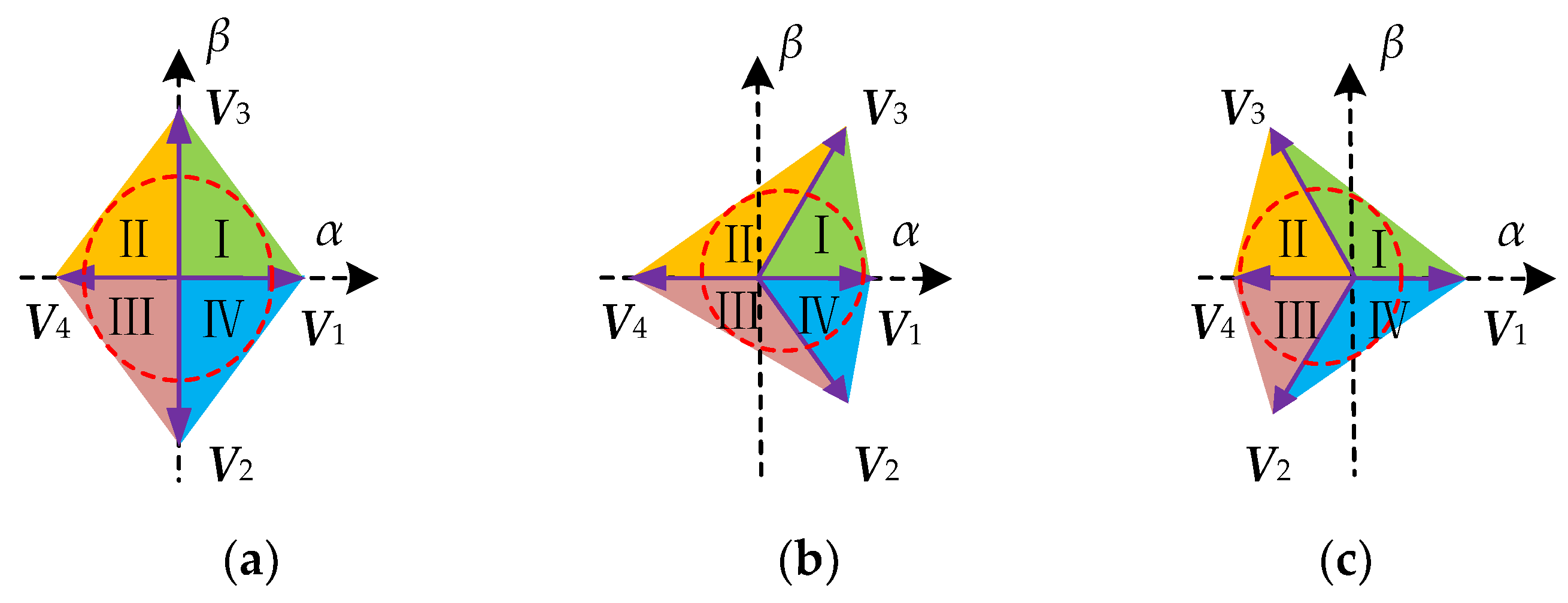
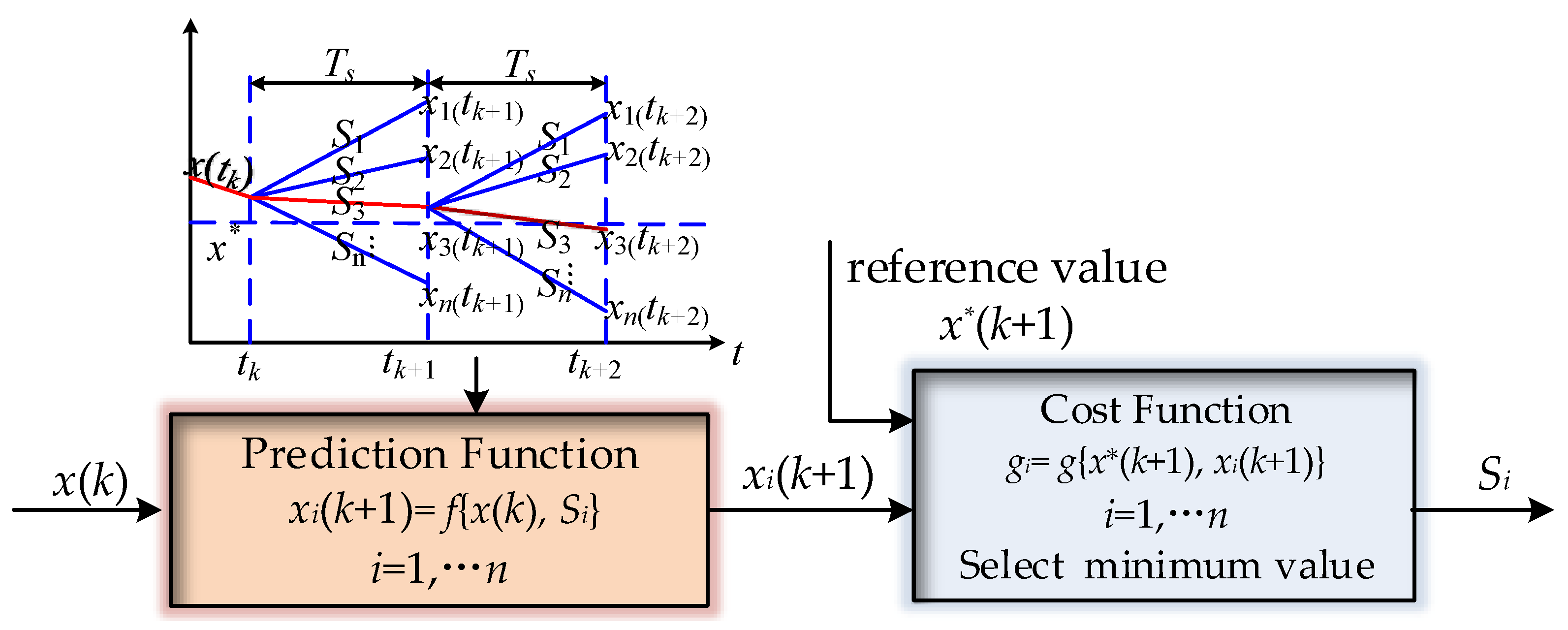
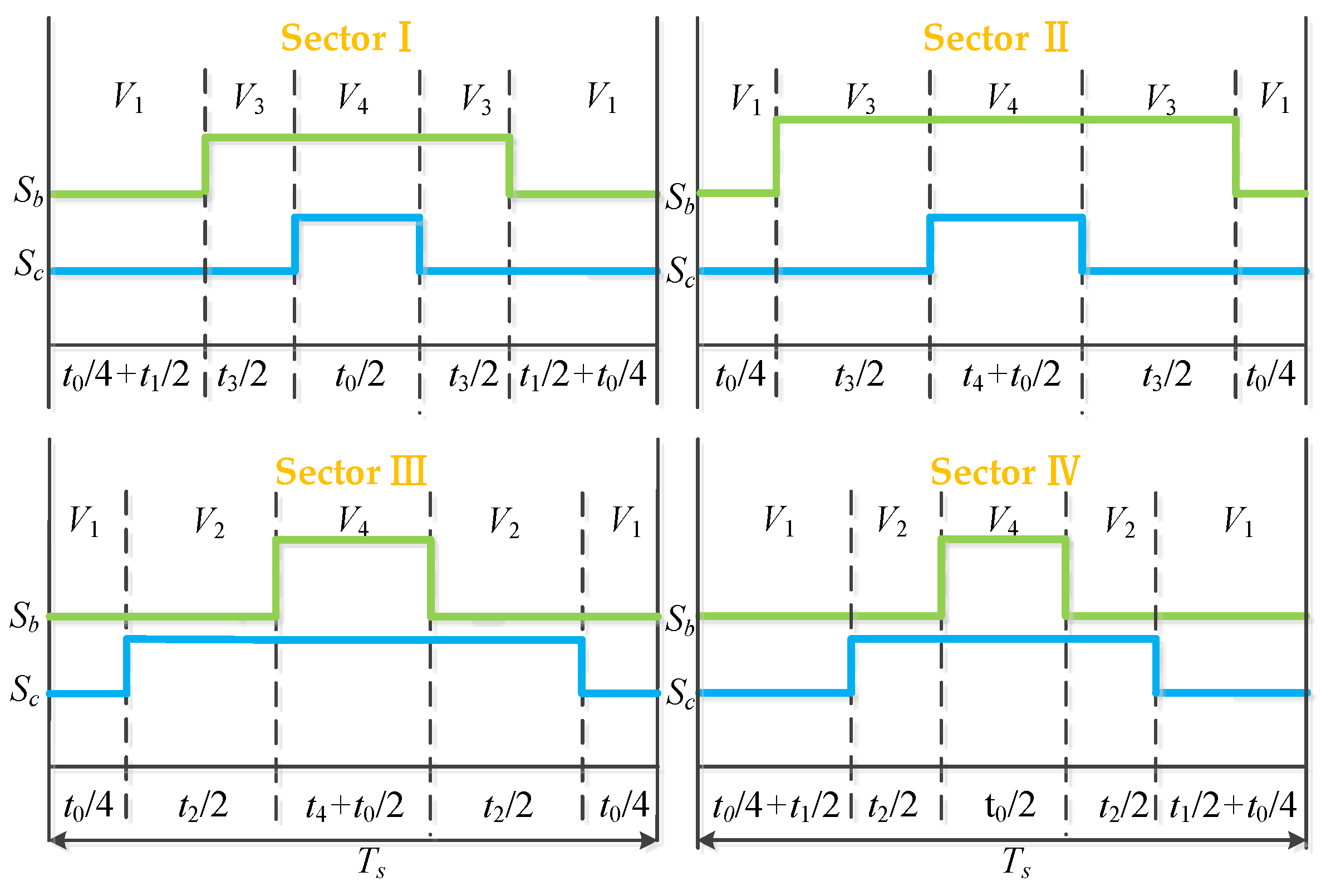
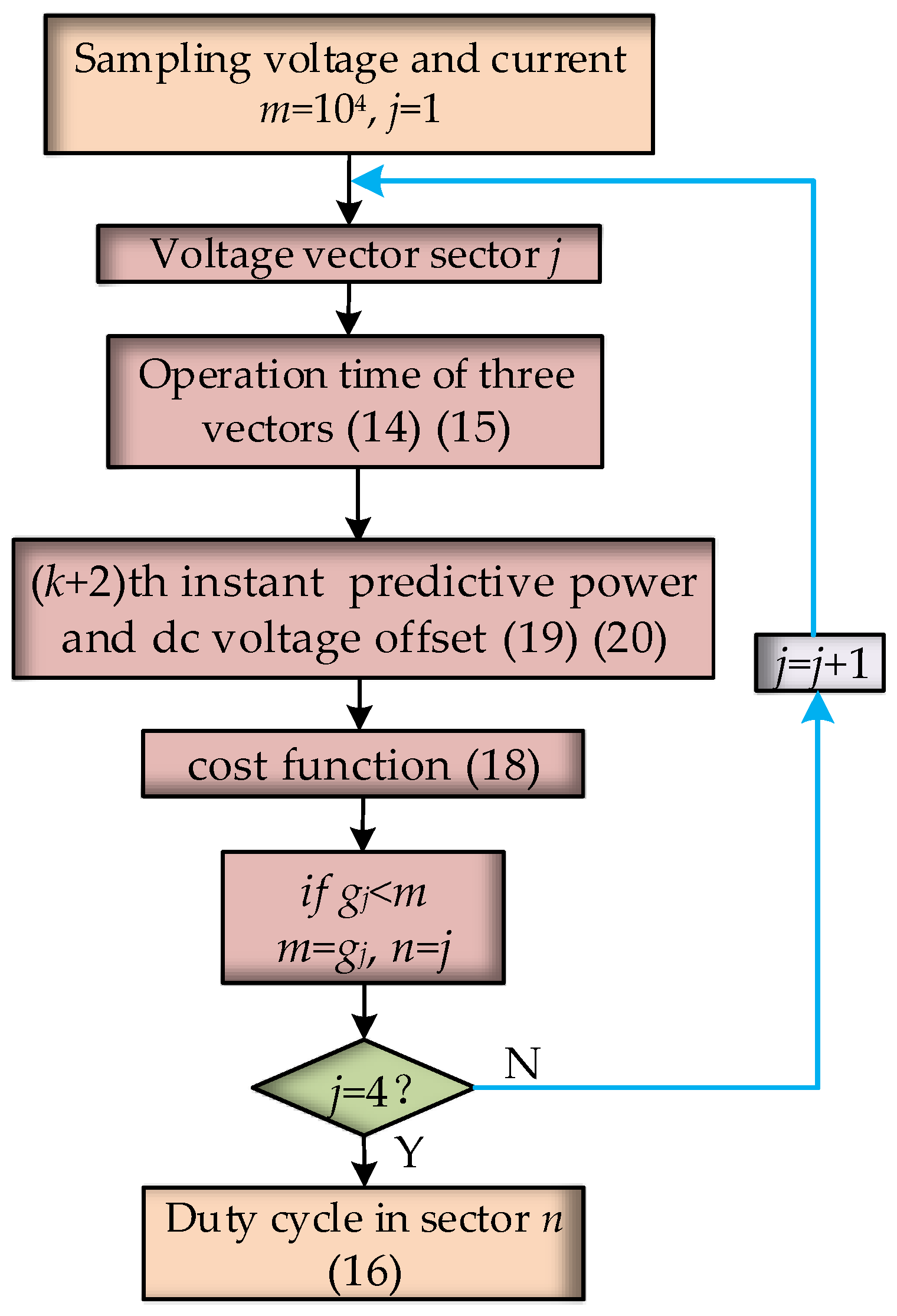
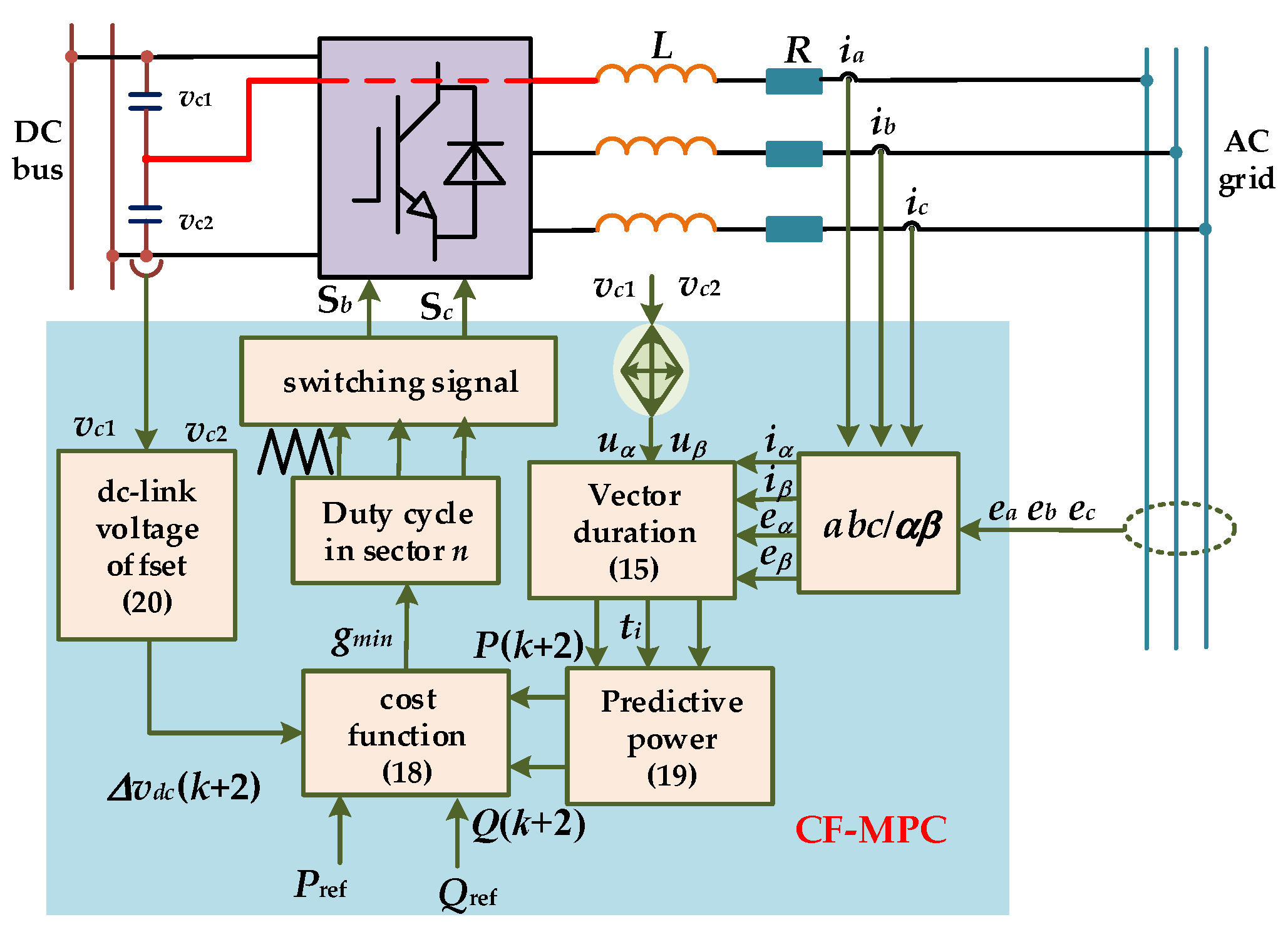
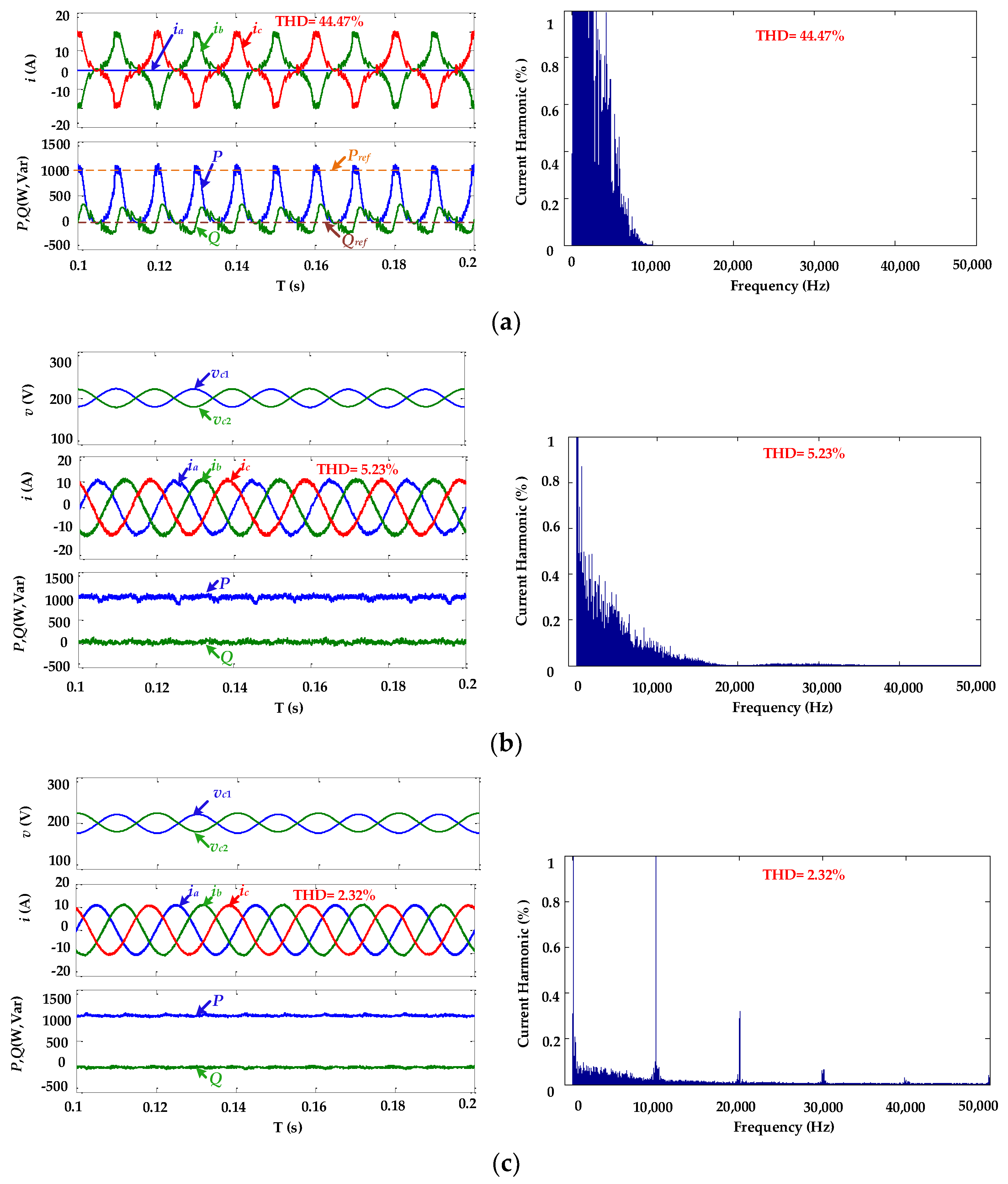
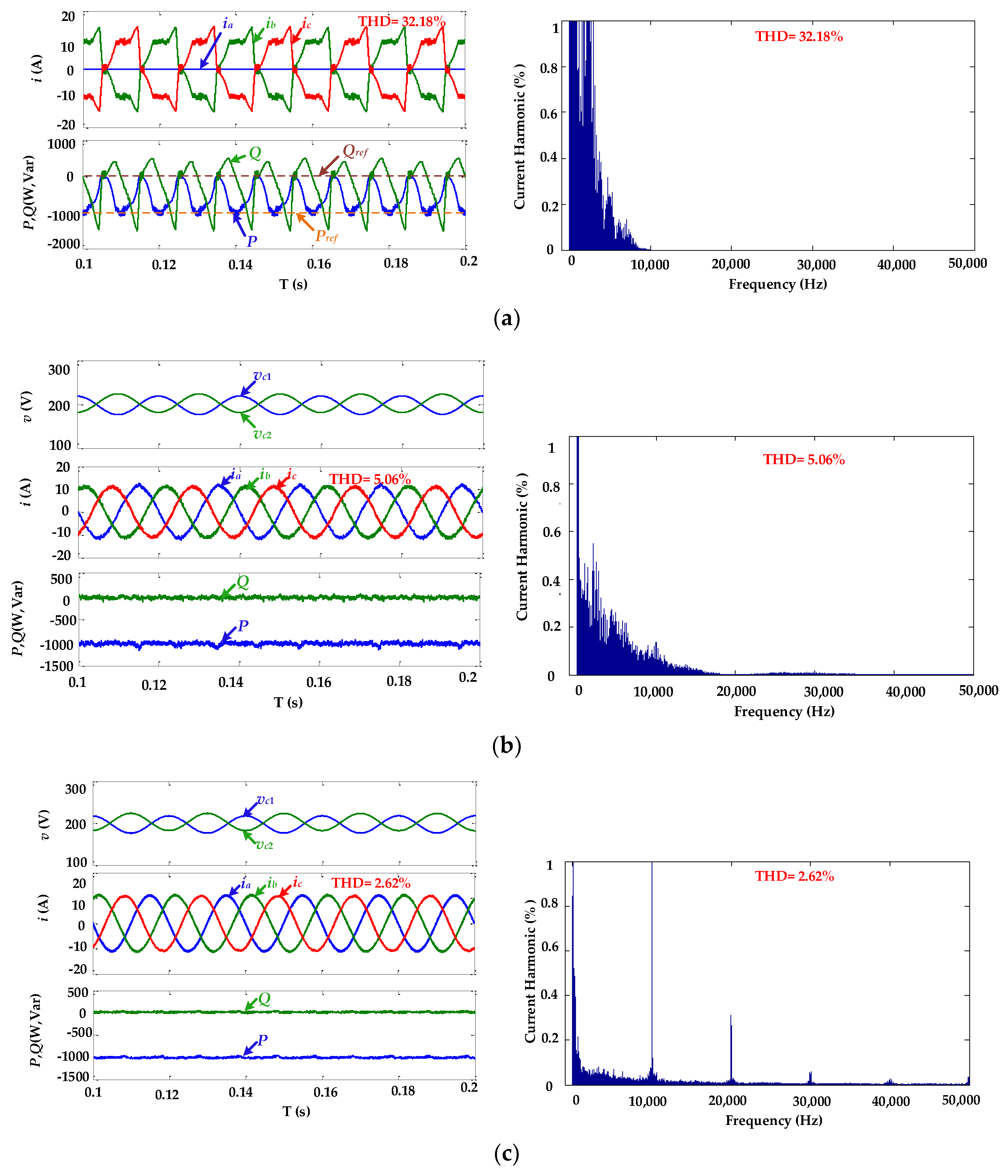
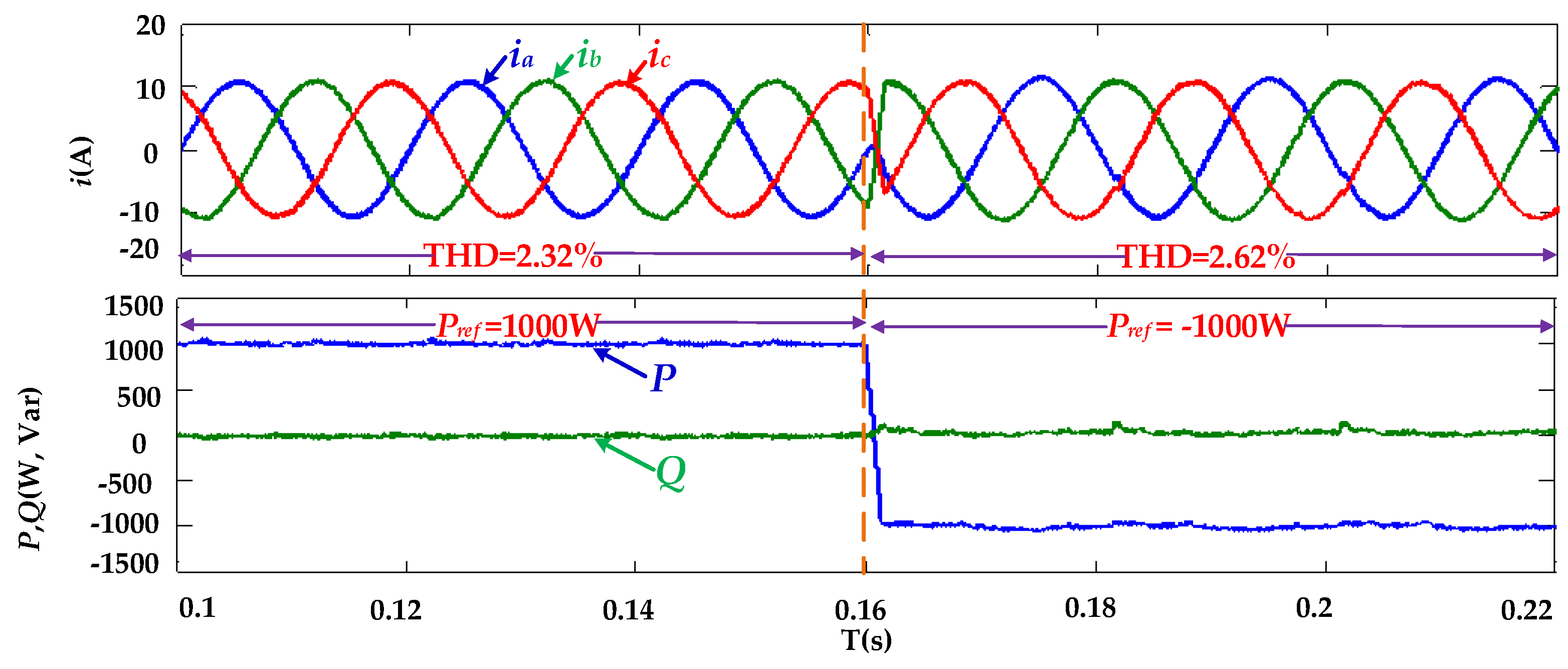
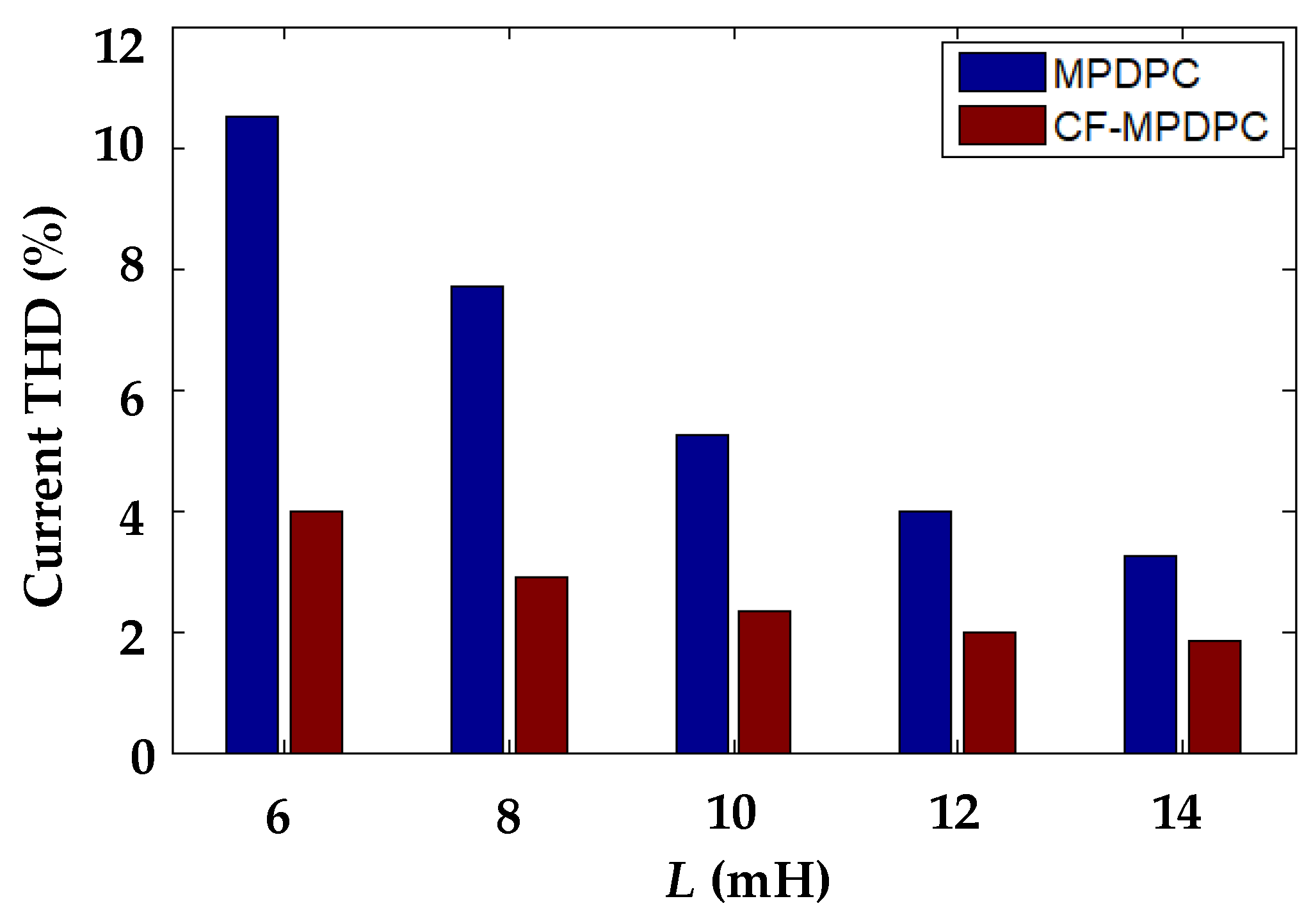
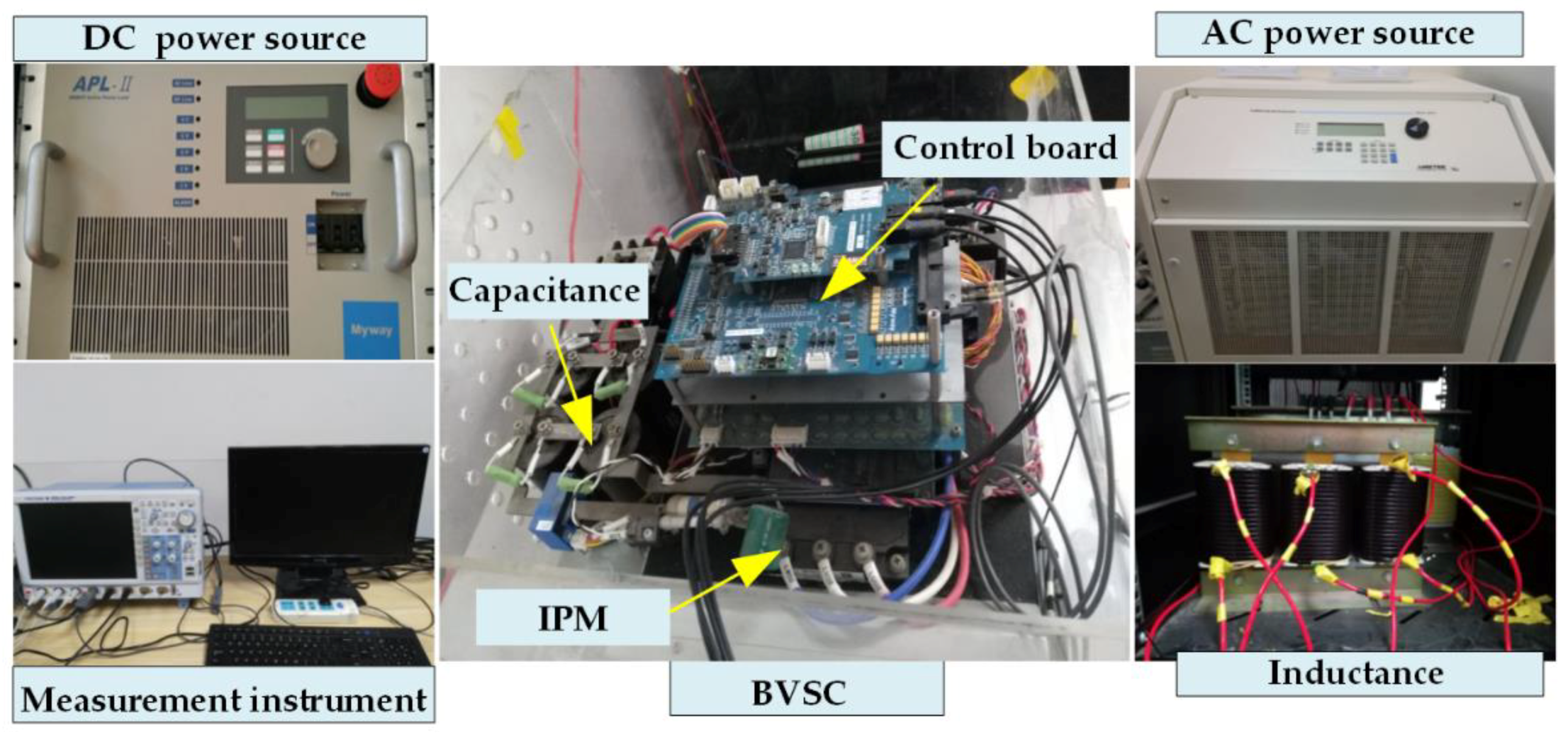

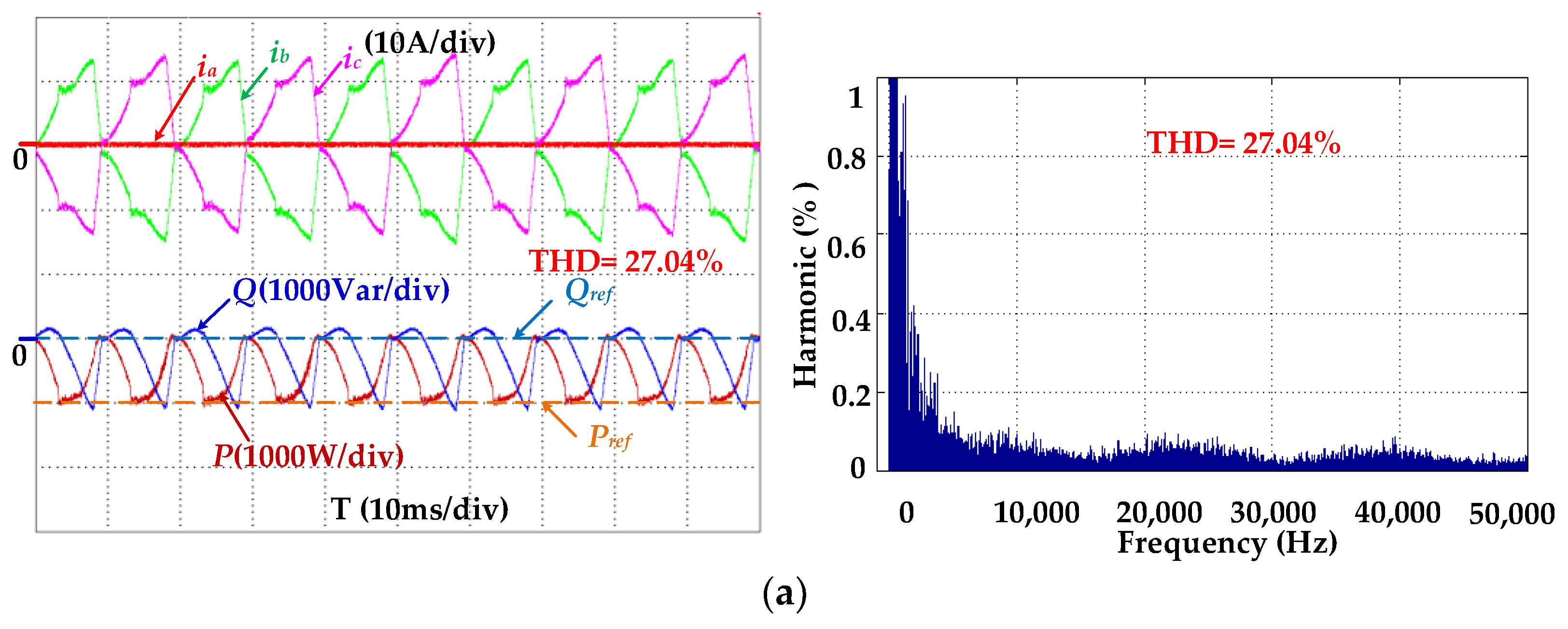

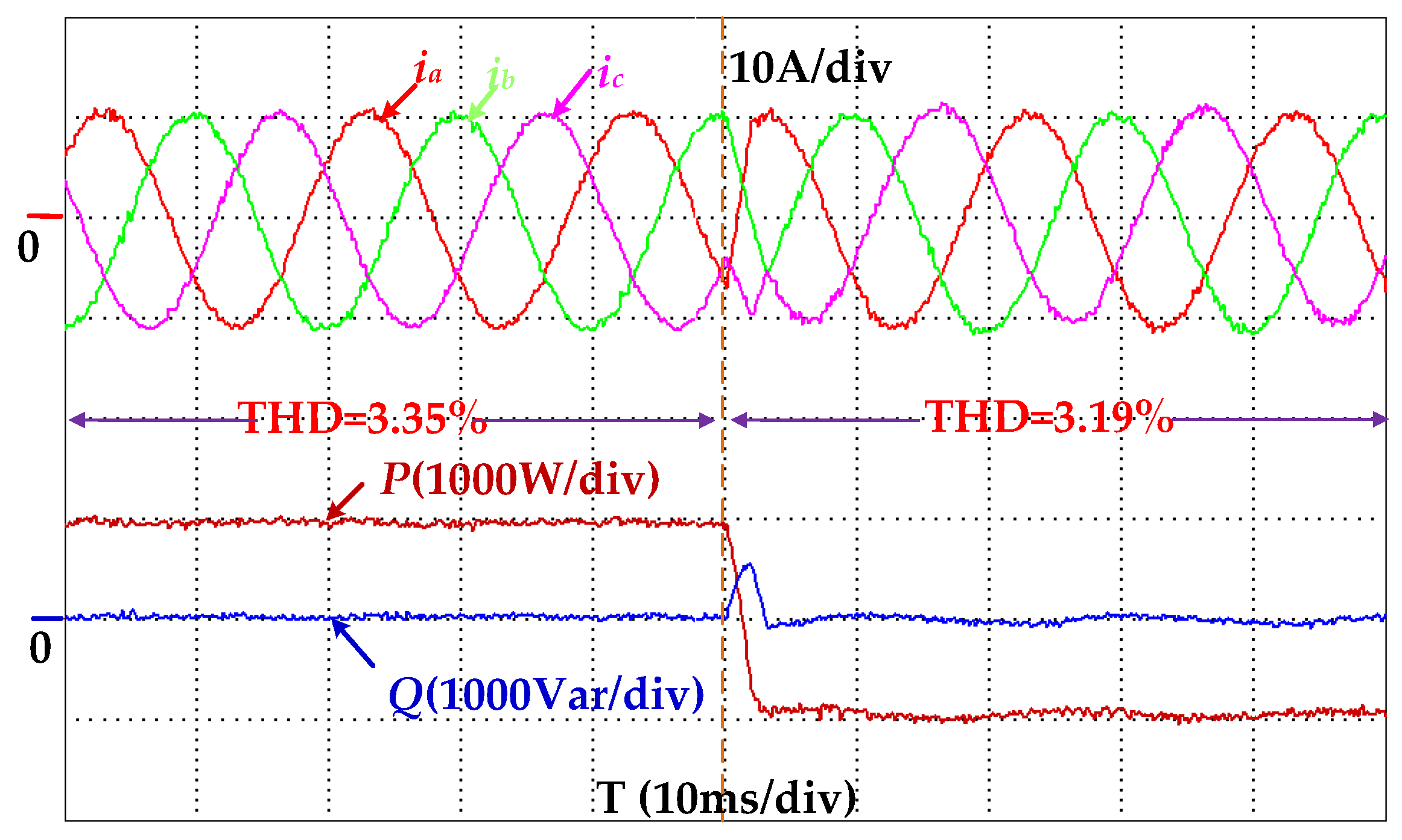
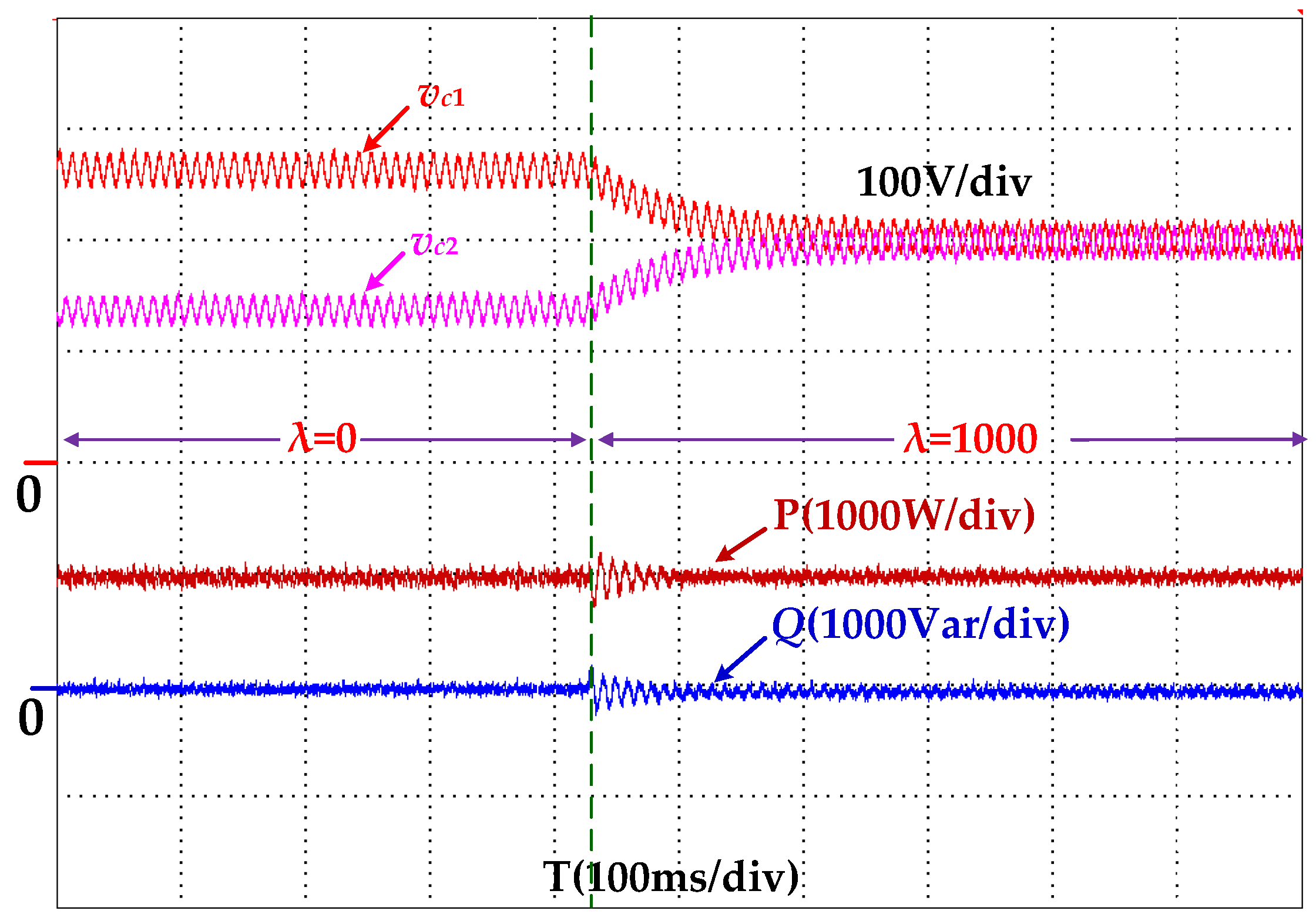
| Voltage Vector | Switching State (Sb, Sc) | uα | uβ |
|---|---|---|---|
| V1 | (0, 0) | 2vc2/3 | 0 |
| V2 | (0, 1) | (vc2−vc1)/3 | |
| V3 | (1, 0) | (vc2−vc1)/3 | |
| V4 | (1, 1) | −2vc2/3 | 0 |
| Symbol | System Parameters | Value |
|---|---|---|
| vdc | DC voltage | 400 V |
| C1, C2 | Capacitance | 1000 μF |
| L | Filter inductance | 10 mH |
| R | Line resistance | 0.2 Ω |
| e | AC line voltage | 110 V |
| f | Grid frequency | 50 Hz |
| λ | Weighting factor | 1000 |
| fs | Sampling frequency | 20 kHz |
| Inductance | 6mH | 8mH | 10mH | 12mH | 14mH |
|---|---|---|---|---|---|
| MPDPC | 10.5% | 7.7% | 5.23% | 3.98% | 3.23% |
| CF-MPDPC | 4% | 2.88% | 2.32% | 2% | 1.85% |
| Working Mode | Control Method | THD |
|---|---|---|
| Inverter mode | MPDPC for BVSC | 50.57% |
| MPDPC for TPFS converter | 5.26% | |
| CF-MPDPC for TPFS converter | 3.29% | |
| Rectifier mode | MPDPC for BVSC | 27.04% |
| MPDPC for TPFS converter | 5.53% | |
| CF-MPDPC for TPFS converter | 3.21% |
© 2018 by the authors. Licensee MDPI, Basel, Switzerland. This article is an open access article distributed under the terms and conditions of the Creative Commons Attribution (CC BY) license (http://creativecommons.org/licenses/by/4.0/).
Share and Cite
Hu, S.; Liu, G.; Jin, N.; Guo, L. Constant-Frequency Model Predictive Direct Power Control for Fault-Tolerant Bidirectional Voltage-Source Converter with Balanced Capacitor Voltage. Energies 2018, 11, 2692. https://doi.org/10.3390/en11102692
Hu S, Liu G, Jin N, Guo L. Constant-Frequency Model Predictive Direct Power Control for Fault-Tolerant Bidirectional Voltage-Source Converter with Balanced Capacitor Voltage. Energies. 2018; 11(10):2692. https://doi.org/10.3390/en11102692
Chicago/Turabian StyleHu, Shiyang, Guorong Liu, Nan Jin, and Leilei Guo. 2018. "Constant-Frequency Model Predictive Direct Power Control for Fault-Tolerant Bidirectional Voltage-Source Converter with Balanced Capacitor Voltage" Energies 11, no. 10: 2692. https://doi.org/10.3390/en11102692
APA StyleHu, S., Liu, G., Jin, N., & Guo, L. (2018). Constant-Frequency Model Predictive Direct Power Control for Fault-Tolerant Bidirectional Voltage-Source Converter with Balanced Capacitor Voltage. Energies, 11(10), 2692. https://doi.org/10.3390/en11102692





